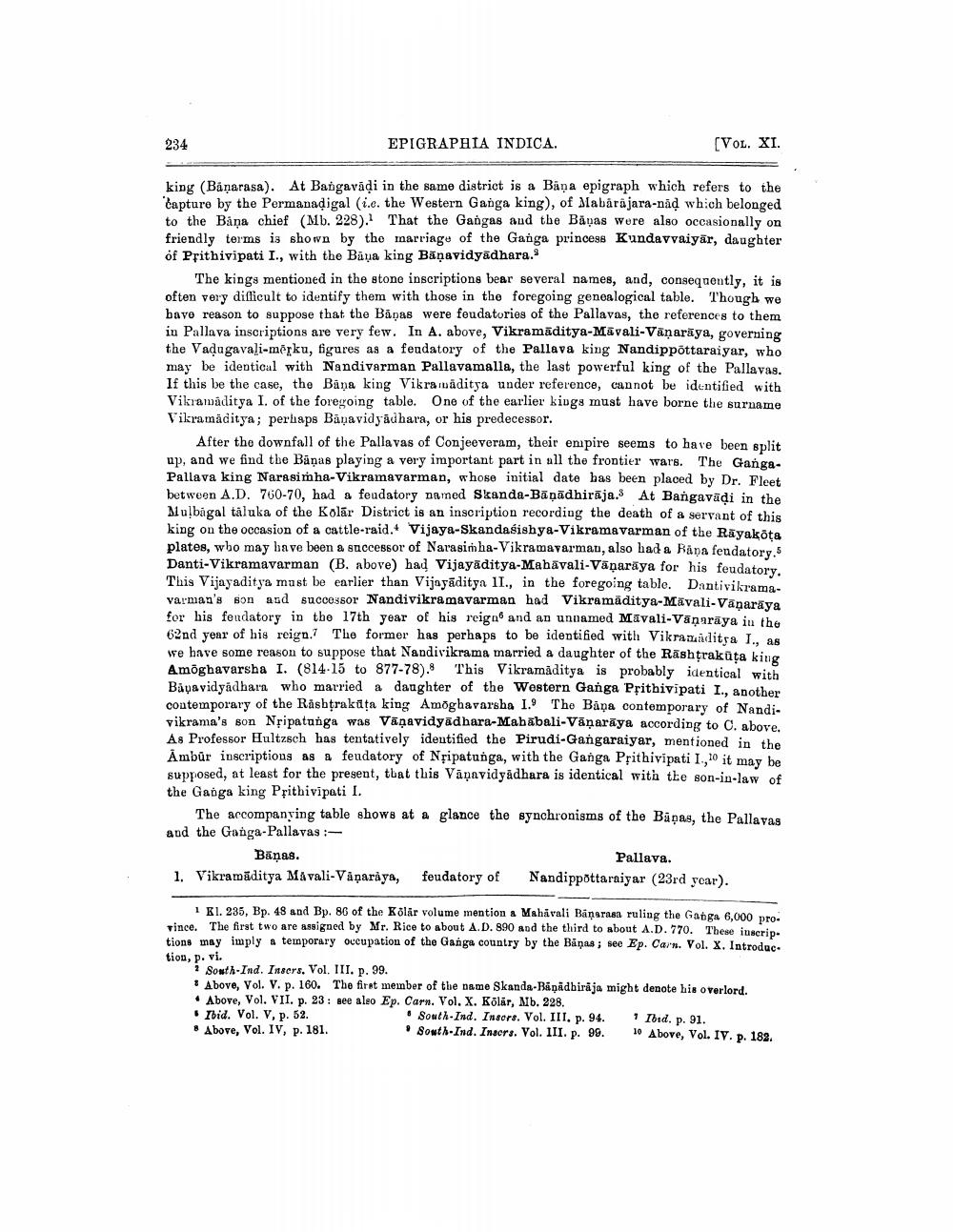________________
234
EPIGRAPHIA INDICA.
[VOL. XI.
king (Banarasa). At Bangavaḍi in the same district is a Bana epigraph which refers to the capture by the Permanaḍigal (i.e. the Western Ganga king), of Mabarajara-nad which belonged to the Bana chief (Mb. 228). That the Gangas and the Banas were also occasionally on friendly terms is shown by the marriage of the Ganga princess Kundavvaiyar, daughter of Prithivipati I., with the Baua king Baṇavidyadhara."
The kings mentioned in the stone inscriptions bear several names, and, consequently, it is often very difficult to identify them with those in the foregoing genealogical table. Though we have reason to suppose that the Bapas were feudatories of the Pallavas, the references to them in Pallava inscriptions are very few. In A. above, Vikramaditya-Mavali-Vanaraya, governing the Vaḍugavali-mērku, figures as a feudatory of the Pallava king Nandippōttaraiyar, who may be identical with Nandivarman Pallavamalla, the last powerful king of the Pallavas. If this be the case, the Bana king Vikramaditya under reference, cannot be identified with Vikramaditya I. of the foregoing table. One of the earlier kings must have borne the surname Vikramaditya; perhaps Baṇavidyadhara, or his predecessor.
After the downfall of the Pallavas of Conjeeveram, their empire seems to have been split up, and we find the Banas playing a very important part in all the frontier wars. The GangaPallava king Narasimha-Vikramavarman, whose initial date has been placed by Dr. Fleet between A.D. 760-70, had a feudatory named Skanda-Baṇadhiraja. At Bangavaḍi in the Mulbagal taluka of the Kolar District is an inscription recording the death of a servant of this king on the occasion of a cattle-raid. Vijaya-Skandasishya-Vikramavarman of the Rayakōṭa plates, who may have been a successor of Narasimha-Vikramavarman, also had a Rapa feudatory.5 Danti-Vikramavarman (B. above) had Vijayaditya-Mahavali-Vanaraya for his feudatory. This Vijayaditya must be earlier than Vijayaditya II., in the foregoing table. Dantivikramavarman's son and successor Nandivikramavarman had Vikramaditya-Mavali-Vanaraya for his feudatory in the 17th year of his reign and an unnamed Mavali-Vanaraya in the 62nd year of his reign. The former has perhaps to be identified with Vikramaditya I., as we have some reason to suppose that Nandivikrama married a daughter of the Rashtrakuta king Amoghavarsha I. (814-15 to 877-78).8 This Vikramaditya is probably identical with Bapavidyadhara who married a daughter of the Western Ganga Prithivipati I., another contemporary of the Rashtrakuta king Amoghavarsha 1.9 The Bapa contemporary of Nandivikrama's son Nripatunga was Vaṇavidyadhara-Mahabali-Vanaraya according to C. above. As Professor Hultzsch has tentatively identified the Pirudi-Gangaraiyar, mentioned in the Ambur inscriptions as a feudatory of Nripatunga, with the Ganga Prithivipati I.,10 it may be supposed, at least for the present, that this Vapavidyadhara is identical with the son-in-law of the Ganga king Prithivipati I.
The accompanying table shows at a glance the synchronisms of the Banas, the Pallavas and the Ganga-Pallavas :
Bāņas.
Pallava. Nandippottaraiyar (23rd year).
1. Vikramaditya Mavali-Vanaraya, feudatory of
1 Kl. 235, Bp. 48 and Bp. 86 of the Kölär volume mention a Mahavali Banarasa ruling the Ganga 6,000 province. The first two are assigned by Mr. Rice to about A.D. 890 and the third to about A.D. 770. These inscrip tions may imply a temporary occupation of the Ganga country by the Banas; see Ep. Carn. Vol. X. Introduc tion, p. vi.
South-Ind. Insers. Vol. III. p. 99.
Above, Vol. V. p. 160. The first member of the name Skanda-Bänädhiraja might denote his overlord.
Above, Vol. VII. p. 23: see also Ep. Ibid. Vol. V, p. 52.
8 Above, Vol. IV, p. 181.
Carn. Vol. X. Kōlär, Mb. 228.
South-Ind. Insors. Vol. III. p. 94. South-Ind. Insors. Vol. III. p. 99.
1 Ibid. p. 91.
10 Above, Vol. IV. p. 182.




